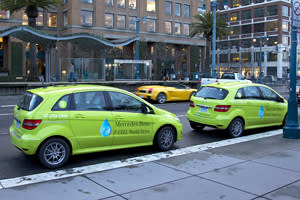Mercedes-Benz reinvents the automobile
The Mercedes-Benz F-CELL gives U.S. customers the option of going completely off the grid.
Green cars typically don’t turn heads in eco-obsessed San Francisco, where hybrids are common and even $100,000 electric Tesla Roadsters aren’t rare. But when a trio of Mercedes-Benz F CELL cars recently trolled the city’s streets, hands waved and horns honked. For it’s not often that you catch a concrete glimpse of the future.
Mercedes brought these four-door, B-Class machines to the city by the bay as part of a 125-day, January-to-June, 18,000-mile global trek to mark the 125th anniversary of Carl Benz’s invention of the automobile. In many ways, these cars represent as radical a leap as when Benz first introduced his motorized contraption. While the alt-fuel focus of most auto companies remains gas-electric and pure electric engines, a few companies remain committed to the so-called fuel cell vehicle.
In the simplest terms: A fuel cell-powered car carries tanks filled with hydrogen, which when exposed to oxygen generate electricity that’s stored in lithium-ion batteries. The main emission is simple water. Mercedes’ F CELL can get about 400 kilometers (250 miles) per four-kilogram tank of hydrogen, which means about a $48 fill-up at a European hydrogen depot. The F CELL’s potential leaves one particular engineer almost giddy.
“Think about it, this is a car with a range of 250 miles, a three-minute refueling time, with full safety and reliability,” says Christian Mohrdieck, director of Daimler’s fuel cell and battery development program. “There are two obstacles only. Infrastructure and cost. But both those things can be worked on.”
The good news? Americans can drive the F CELL today. The bad news? Not that many of us. Mercedes-Benz is leasing 200 cars worldwide; three have already been delivered to drivers in southern California, presently one of the only reliable places stateside to fill up on hydrogen. The lease program costs $849 a month, fill-ups included, and anyone interested should apply at www.mbusa.com/fcell.
Mohrdieck says that he and his engineers are working on making the fuel cell itself smaller, and moving it from a sub-floor position to “the same spot that would be occupied by a four-cylinder diesel engine,” which in turn frees up even more passenger room. He estimated that the ideal price point for an F CELL would be “around why you might pay for a diesel hybrid vehicle, which I think we could achieve if we could build them in enough volume.”
That doesn’t mean Mercedes-Benz envisions a hydrogen-fleet future. Mohrdieck says the company plans to always maintain “a wide variety of drivetrain technologies” and that in 10 years time perhaps 1 percent of Mercedes sales could be fuel cell vehicles.

So what about the real limiting factor: hydrogen stations? “Look,” says Mohrdieck, “100 years ago cars were such new things that people would go to pharmacies to get gas. That’s where we are now with hydrogen, but we’re working with companies such as (Munich-based) The Linde Group (a global leader in specialty gas production) to see that filling these cars becomes easier and easier.”
Driving an F CELL through the streets of San Francisco makes one want the hydrogen revolution to begin. The spacious B-Class scoots about its business with a confident electric-car hum. While the interior eschews wood and leather for quality cloth and plastic (weight savings is the name of this game), the car displays a structural integrity common to products from the Three-Pointed Star. Simple dash readouts monitor hydrogen consumption; in the place of a tachometer is a dial that goes from green to white to red. In the red you’re burning hydrogen in a hurry, while deep green means you’re actually recuperating electric energy through regenerative braking.
But the real breakthrough of the F CELL is that you could ignore all such inputs and be convinced you were simply zipping around town in the family machine, your only footprint being the occasional stream of water trickling out of your tailpipe.

 Yahoo Autos
Yahoo Autos 
